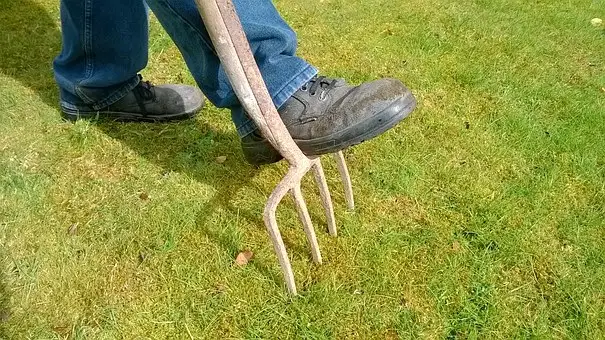
The term aerating your lawn can sometimes intimidate people and make them feel they can’t do it themselves. Well, if your lawn is small in size, you can actually do it yourself with a little time and & work.
In this post, we are going to cover how to aerate your lawn without machines. In hopes that it makes you feel more confident in doing it yourself.
What Is Aerating Your Lawn?

Aerating your lawn involves loosening the soil by creating holes throughout it. This helps the grass to grow vigorously and reduce thatch, moss, and other lawn problems.
It also helps when planting seeds so they settle deep into the soil and will get good root growth.
This could be done with a machine or with hand tools. Hand tools consist of a hand aerator (which has a set of hollow holes that you push into the ground) & the others are spading forks and even aeration shoe soles you attach to your feet.

When To Aerate Your Lawn
When you aerate your lawn, it helps your lawn to get water & nutrients supplied to the roots better. If your soil becomes compacted, this could affect that process.
If you can’t push a screwdriver through your moistened soil, then it is probably time to consider aerating it. If you have a lawn that isn’t always trampled through, it probably will be okay being done every 2 to 3 years.
High traffic areas will most likely result in compacted turf & soil. In this case, it probably would be good to do once a year.
The area you live in also has something to do with it, as far as what time of year to do it. Because different climates call for different types of grass, you should aerate with warm-season grass (Bermuda, Carpet Grass, Centipede, St. Augustine & Zoysia) in the late spring. Cool-season grass (Bentgrass, Bluegrass, Fescue & Rye Grass) should be done in the fall.
Procedures for Aerating Your Lawn
Before starting, you want to make sure the soil has the right moisture. If it is too wet or dry, you want to wait until it is right in between the two.

This is determined by this example. Using a hand aerator, which has 1/4 to 1/2 inch diameter tubes on it. Push the tubes through the soil. If the dirt sticks to the tubes, then it is too wet. If it is powdery and fine or too difficult to push in, it is too dry.
If it is too wet, wait a few days and try it again. If it is too dry, water it normally for 2 to 3 days and try it again. The soil should be moist enough to go at least 4 inches in depth.
Once the soil is right, then rake up any heavy thatched area (dead grass, moss, and all other debris) and remove it from the lawn.
Now you want to push the tubes down through the soil at least 4 inches deep and pull them out. This will bring out cores of soil, leaving your aeration holes. Do this every 4 to 6 inches through the area you are aerating.

Leave the cores on the lawn, and when finished, you want to take the back of the rake and break them down into the lawn area. But don’t remove them from the lawn.
If you want to overseed, this is the time to do it.
The other option is using a spading fork, pushing it down about 4 inches, and rocking it

back & forth loosening the soil. You do this also about every 4 to 6 inches throughout the area you are aerating.
You have just aerated your lawn with no machines. It may have taken a little more work, but you got it done.
Thank you for visiting, and I hope this post helped someone today. If you need any tools or products, you can visit the Old School Lawn Store on this site. Please leave any questions or comments in the comment section below.
